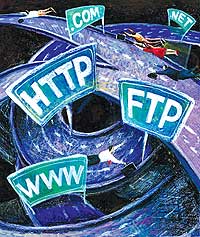 It a time when only one percent of Nepal's total population has access to telecommunications, maximising the general mass' access to the Internet seems a Herculean task. More so when 90 percent of around 25,000 Internet account holders use the dial-up system that needs a telephone connection. This is perhaps one of the foremost reasons why only 0.1 percent of Nepal has access to what information technology (IT) is available in the country.
It a time when only one percent of Nepal's total population has access to telecommunications, maximising the general mass' access to the Internet seems a Herculean task. More so when 90 percent of around 25,000 Internet account holders use the dial-up system that needs a telephone connection. This is perhaps one of the foremost reasons why only 0.1 percent of Nepal has access to what information technology (IT) is available in the country. On average, Internet Service Providers (ISPs) charge a little above 20 paisa per minute for access to the net but Nepal Telecommunication Corporation's (NTC) normal charges are Rs 3 per call. This adds up to consumers shelling out more money to cruise the information highway. So, even among those who have dial-up connections, most keep their time on the net to a minimum because of expensive phone bills.
Despite the costs, there would be more users if the services were problem-free but more and more users are having difficulties while logged on. ISPs say the backbone of the problem lies in telephone networks and availability and complain that NTC has not given them additional phone lines to cope with the increasing demand of Internet users. "Getting new telephone lines is the real hassle," says Worldlink's Dileep Aggrawal. "We run the business and they (NTC) determine how many telephone lines we need, which is impractical."
A representative of an established Kathamndu-based ISP told us that NTC views them as rivals since the corporation also offers internet services, which unfortunately has been unsuccessful. "It couldn't run it's business and it doesn't allow other ISPs to grow," he said. "That is why it does not let us have even the adequate number of phone lines."
Plagued ISPs have begun to resort to means to bypass NTC's telephone service. The new hi-tech option is wireless access. It's catching on slowly but comes with its own problem-the possibility of snags between operators and the government. Wireless ISPs need to get radio frequencies from the Ministry of Information and Communication. They say that their greatest hurdle is importing required equipment because three different ministries must approve it: the Nepal Telecommunication Authority, the Finance Ministry and the Ministry of Information and Communication. Additionally, the law requires wireless providers to get an annual license that costs around Rs 10,000. Some ISPs have skipped that step and jumped straight to delivering wireless service-to those that can afford it.
While ISPs have managed to ease their way out of NTCs grasp, they run the risk of the government clamping down and declaring wireless service illegal in Nepal. "We are left in confusion," says Binay Bohara of Vianet Communications. "Given the circumstances, we need to have the wireless system, but if we start using it the government may confiscate our equipment because the laws are still unclear."
The answer could lie in fibre optic connections-a promising medium that could maximise the reach of IT. Several companies are eager to begin, waiting only for the government to formally give permission. The task of installation will take ISPs back to where they began-with the government owned NTC that will have the monopoly in distribution and tariffs, just as it does with coaxial cable telephone lines.
NTC officials admit their policy has created an adverse atmosphere to certain degree, but accuse the private sector of being lax with delivering quality service to consumers, stating the narrow bandwidths require Internet users to stay logged on for longer. "If they are there to give better service, they should increase their bandwidth by linking with the satellites they use," an NTC official told us.
IT experts underline the dearth of local content in Nepali on the Internet is a deterrent. ISPs spend around $2,500 for the international circuit where as the price could be much cheaper if the content was local and distributed by a server in Nepal (see 'For the people' ). They believe the Internet would then truly be accessible-even grocers would surf the net for information and price comparisons. The prolific cybercafes around Nepal would see a diverse and increased number of users, apart from the current breed of young urban youth.
For the digital divide to narrow, policies and cyberlaws-for example on the issue of copyright-must be examined and implemented. "We are making the review and trying to make the IT policy timely," says Sharad Chandra Shah, Vice Chairman at the newly formed High Level IT Commission. "If necessary, we will even bypass bureaucratic red tape."


